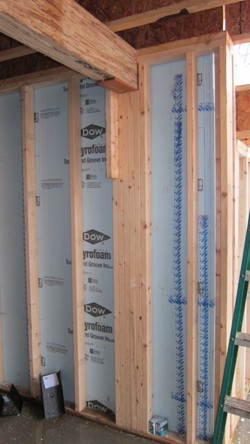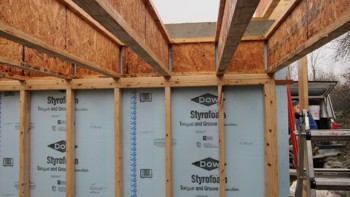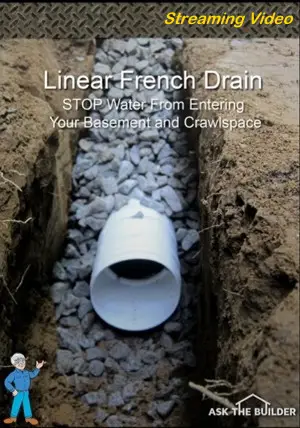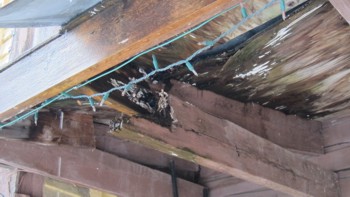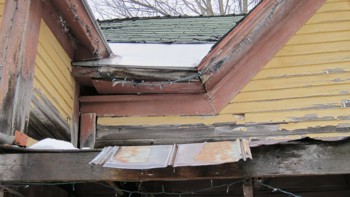What's in This Newsletter?
Latest News
Tool & Product Reviews
New Feature - Your Project!
Cheryl & the South Africa Hardware Store
Tub or Tile First?
Wet-Dry Vac Guide
Winter Fireplace & CO Danger
Touch Not This Wall
Facebook News
Yesterday I was up on my land in New Hampshire burning some brush piles before the rain and snow hit.Once the fires were started, I was doing some clean up. There are any number of traditional stacked rock walls on the land, and some of the rocks have tumbled to the ground.
I was trying to lift a few and pulled a muscle in my back. That's when the light bulb went off in my head about Wally.
I came across Wally Wallington about four or five years ago. I can't remember how I found him, but by gosh if you've not seen him, you NEED to.
Faced with a situation on a construction site where he was working, Wally figured out on his own a method that early people could have used to build The Great Pyramids and Stonehenge. He calls it The Forgotten Technology.
The best part is he's actually created full-size stones and moved them by himself to prove this.
Wally has a DVD that shows you exactly how to move 10 ton blocks of stone sideways or up as high as you want - totally by yourself.
You're insane if you don't order this. It makes the perfect stocking stuffer for this Christmas.
If you mention my name when you order, he'll give you a $2 discount.
Be sure to go to the bottom to see the latest book I read.
Tool and Product Reviews and Ads
I try to feature new tools and products as often as possible in this newsletter.
A month ago, I was talking with Dan, a close friend of mine, and he told me that I keep forgetting to mention to you that I don't feature things that FAIL my testing.
DUH! My policy had been to not say a word because I didn't want to harm the company. I also may expose myself to some liability. A company may say my testing was flawed and that I caused them millions of dollars of lost sales.
Suffice it to say that when I mention something in this newsletter, it's a product I would use in or on my home.
New Feature - Your Project!
I'm starting a new feature in the newsletter. I want to feature your home improvement victories!
While it can be anything, it would be great if you have done a project using some of my advice. For example, I regularly get photos and emails from people who have grouted a tile floor using my four-part series.
All you have to do is send photos to me, a description of the project, what you discovered, etc. and a note saying I have permission to post the content on my website and in the newsletter.
If you have a video and have uploaded it to YouTube or some other sharing website, I'll use the embed code as well. Send me the link to the video.
Let's see your sweet skills and magic! Send me stuff! Show off your work!
Cheryl and the South Africa Hardware Store
Cheryl wrote to me after I published the tip about using emery boards to sand with.
"I thought I would share a lighter moment of sanding with you. I have a little sanding machine made by Black and Decker called a "Mouse". I'm not sure if you get them in the States.
In South Africa, it's fairly unusual to have women doing woodwork. I went down to our little local hardware store where I was approached by one of the sales assistants with the usual condescending attitude. I asked him to point me to the sandpaper as I needed sand paper for the mouse.
With absolute pity in his voice, he replied that I should rather try the pet shop next door. No amount of explaining could convince him that I was sane."
Cheryl, let's hope the sexist store clerk also subscribes to this newsletter and the next time you see him, he has well-deserved egg all over his face!
Tub or Tile First?
Gordon Berry wrote to me:
"I really appreciate all the information your newsletters. I'm replacing a bath tub and tiling the bathroom floor. Is it better to tile the whole floor and then install the tub on the tile, or is it better to install the tub on the floor then tile up to the tub?"
Gordon, I absolutely put the tub in first if it's one that just has the front apron. If it's a decorative tub like a claws foot or soaking tub that is finished on all sides, then I do put the tile floor in first.
You install heavy tubs with an apron first because there's too great a danger you'll damage the tile moving the tub into place.
In the past, I've done some crazy things to minimize the chance of wood rot when I place a tub on a wood sub-flooring system.
I like to apply two coats of urethane to the wood floor system before the tub install. I then lay down 30-pound felt paper on the floor under the tub and under the tile underlayment. I lap the felt paper up on the walls about an inch and a half.
The tile needs to be installed after the drywall is complete and you've possibly even painted. I do install the tile under the toilet and absolutely under vanity or other cabinets in the room.
Wet-Dry Vac Guide - Unique Uses
Oh my, you know the saying, "Be careful what you wish for."
You may have been one of the well over 100 subscribers that sent an email to me about a cool way you use your wet-dry vacuum.
Well, the guide is almost finished. Each day several new uses dribble in. I'm going to have it all ready for you next Tuesday.
Wait till you see how Anne plans to use hers in a few years. Oh my!
Winter Fireplace and CO Danger
Bill Hannigan of North Ft. Myers, FL wrote to me after the last newsletter:
"Your recent newsletter reminded me of an incident a friend experienced some time ago that could have led to loss of life and home.
He had mounted a pretty powerful whole house ceiling fan in his upstairs ceiling. The on/off switch was installed on the wall by the stairs. That winter he was coming down the stairs and, without thinking, switched the fan on to check to see if it was working OK.
This pulled embers from the downstairs fireplace onto the living room carpet and smoked up the house. Fortunately the screams from downstairs told him that he had done something wrong, and they were able to save the house but not the carpet. Luckily there were no injuries."
Bill, guess what? I did the same thing about 30 years ago at my sister's house at a family gathering. What a young idiot I was.
This is why I tell people to put whole house fans on a separate circuit and to TURN OFF that breaker once the heating season arrives and fireplaces, furnaces and water heaters are in use.
Whole house fans can be a serious carbon monoxide hazard as these powerful fans will suck massive amounts of air down exhaust vents for boilers, furnaces and water heaters in order to satisfy their voracious appetite for air.
Touch Not This Wall
 About a week ago, I finished reading a very powerful book called Touch Not This Wall by Harley Melton.
About a week ago, I finished reading a very powerful book called Touch Not This Wall by Harley Melton.
Harley is a Vietnam veteran that used his combat experiences overseas to help guide the storyline. It's a book centered around the very special friendships warriors forge when faced with death or severe injury as each hour ticks by.
But the book also dives deeply into what happened with virtually every Vietnam veteran when he/she came back to the World. You start to understand how it can take decades to readjust to a place that had changed oh so dramatically in just a few short years.
I couldn't put this book down. On more than one occasion I was crying. It held a special meaning for me as I found it to be a touchstone about my dad's WW II experiences.
You see, I had to send my dad back to Heaven when I was just 24. I never got the chance to talk to him about his war experiences, so Harley helped me part way across that bridge.
I urge you to order this book if you're a war veteran, know one, are married to one or are the son or daughter of one. It will absolutely help you grasp a better understanding of what war does to the minds and bodies of young men and women.
You can only get the book by mailing cash or a check to Harley.
Send $13 - cash is better - to:
Harley Melton
5480 Laurie Lane
Memphis, TN 38120
For gosh sakes, be sure to include your name and address so Harley knows where to send your book.
Facebook News!
 Do you use Facebook? I've got a Facebook Fan Page that really sees some action during the week.
Do you use Facebook? I've got a Facebook Fan Page that really sees some action during the week.
We have lots of fun there each week. Go look for yourself..
Please go there now and LIKE me so you can start to get FREE tips from me when you login to your Facebook page.
 About a week ago, I finished reading a very powerful book called
About a week ago, I finished reading a very powerful book called 
